GeoBubbleChart[{reg1val1,reg2val2,…}]
makes a geo bubble chart with bubbles centered at the geographic regions regi with sizes vali.
GeoBubbleChart[regionsvalues]
uses a collection of regions regi from regions with corresponding sizes vali from values.
GeoBubbleChart[{data1,data2,…}]
plots data from all the datai.
GeoBubbleChart[{…,w[datai],…}]
plots datai with features defined by the symbolic wrapper w.




GeoBubbleChart
GeoBubbleChart[{reg1val1,reg2val2,…}]
makes a geo bubble chart with bubbles centered at the geographic regions regi with sizes vali.
GeoBubbleChart[regionsvalues]
uses a collection of regions regi from regions with corresponding sizes vali from values.
GeoBubbleChart[{data1,data2,…}]
plots data from all the datai.
GeoBubbleChart[{…,w[datai],…}]
plots datai with features defined by the symbolic wrapper w.
Details and Options
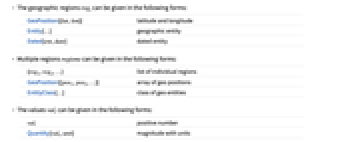
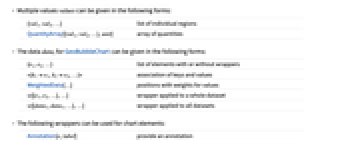
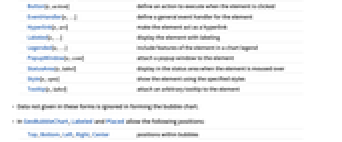
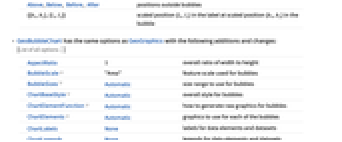
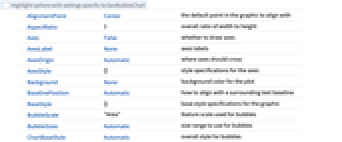
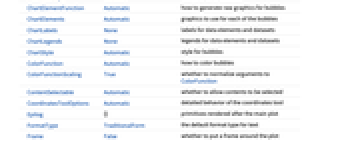
- The geographic regions regi can be given in the following forms:
-
GeoPosition[{lat,lon}] latitude and longitude Entity[…] geographic entity Dated[ent,date] dated entity - Multiple regions regions can be given in the following forms:
-
{reg1,reg2,…} list of individual regions GeoPosition[{pos1,pos2,…}] array of geo positions EntityClass[…] class of geo entities - The values vali can be given in the following forms:
-
vali positive number Quantity[vali,unit] magnitude with units - Multiple values values can be given in the following forms:
-
{val1,val2,…} list of individual regions QuantityArray[{val1,val2,…},unit] array of quantities - The data datai for GeoBubbleChart can be given in the following forms:
-
{e1,e2,…} list of elements with or without wrappers <|k1e1,k2e2,…|> association of keys and values WeightedData[…] positions with weights for values w[{e1,e2,…},…] wrapper applied to a whole dataset w[{data1,data1,…},…] wrapper applied to all datasets - The following wrappers can be used for chart elements:
-
Annotation[e,label] provide an annotation Button[e,action] define an action to execute when the element is clicked EventHandler[e,…] define a general event handler for the element Hyperlink[e,uri] make the element act as a hyperlink Labeled[e,…] display the element with labeling Legended[e,…] include features of the element in a chart legend PopupWindow[e,cont] attach a popup window to the element StatusArea[e,label] display in the status area when the element is moused over Style[e,opts] show the element using the specified styles Tooltip[e,label] attach an arbitrary tooltip to the element - Data not given in these forms is ignored in forming the bubble chart.
- In GeoBubbleChart, Labeled and Placed allow the following positions:
-
Top,Bottom,Left,Right,Center positions within bubbles Above,Below, Before, After positions outside bubbles {{bx,by},{lx,ly}} scaled position {lx,ly} in the label at scaled position {bx,by} in the bubble - GeoBubbleChart has the same options as GeoGraphics with the following additions and changes: [List of all options]
-
AspectRatio 1 overall ratio of width to height BubbleScale "Area" feature scale used for bubbles BubbleSizes Automatic size range to use for bubbles ChartBaseStyle Automatic overall style for bubbles ChartElementFunction Automatic how to generate raw graphics for bubbles ChartElements Automatic graphics to use for each of the bubbles ChartLabels None labels for data elements and datasets ChartLegends None legends for data elements and datasets ChartStyle Automatic style for bubbles ColorFunction Automatic how to color bubbles ColorFunctionScaling True whether to normalize arguments to ColorFunction GeoRangePadding Full how much to pad the geographic range of values LabelingFunction Automatic how to label bubbles LegendAppearance Automatic overall appearance of legends PerformanceGoal $PerformanceGoal aspects of performance to try to optimize PlotTheme $PlotTheme overall theme for the chart TargetUnits Automatic units to display in the chart - GeoBubbleChart layers bubbles from largest to smallest for maximal visibility.
- The arguments supplied to ChartElementFunction are the bubble region {{xmin,xmax},{ymin,ymax}}, the values {xi,yi,zi} and the metadata {m1,m2,…} from each level in a nested list of datasets.
- A list of built-in settings for ChartElementFunction can be obtained from ChartElementData["GeoBubbleChart"].
- The arguments supplied to ColorFunction are x, y and z.
- Chart feature themes affect the data's graphic styling. Themes include:
-

"BoldScheme" bold elements from Chart Element Schemes 
"FadeScheme" faded elements from Chart Element Schemes - Style and other specifications from options and other constructs in GeoBubbleChart are effectively applied in the order ChartStyle, ColorFunction, Style and other wrappers, ChartElements and ChartElementFunction, with later specifications overriding earlier ones.
-
AlignmentPoint Center the default point in the graphic to align with AspectRatio 1 overall ratio of width to height Axes False whether to draw axes AxesLabel None axes labels AxesOrigin Automatic where axes should cross AxesStyle {} style specifications for the axes Background None background color for the plot BaselinePosition Automatic how to align with a surrounding text baseline BaseStyle {} base style specifications for the graphic BubbleScale "Area" feature scale used for bubbles BubbleSizes Automatic size range to use for bubbles ChartBaseStyle Automatic overall style for bubbles ChartElementFunction Automatic how to generate raw graphics for bubbles ChartElements Automatic graphics to use for each of the bubbles ChartLabels None labels for data elements and datasets ChartLegends None legends for data elements and datasets ChartStyle Automatic style for bubbles ColorFunction Automatic how to color bubbles ColorFunctionScaling True whether to normalize arguments to ColorFunction ContentSelectable Automatic whether to allow contents to be selected CoordinatesToolOptions Automatic detailed behavior of the coordinates tool Epilog {} primitives rendered after the main plot FormatType TraditionalForm the default format type for text Frame False whether to put a frame around the plot FrameLabel None frame labels FrameStyle {} style specifications for the frame FrameTicks Automatic frame ticks FrameTicksStyle {} style specifications for frame ticks GeoBackground Automatic style specifications for the background GeoCenter Automatic center coordinates to use GeoGridLines None geographic grid lines to draw GeoGridLinesStyle Automatic style specifications for geographic grid lines GeoGridRange All projected coordinate range to include GeoGridRangePadding Automatic how much to pad the projected range GeoModel Automatic model of the Earth (or other body) to use GeoProjection Automatic projection to use GeoRange Automatic geographic area range to include GeoRangePadding Full how much to pad the geographic range of values GeoResolution Automatic average distance between background pixels GeoScaleBar None scale bar to display GeoServer Automatic specification of a tile server GeoZoomLevel Automatic zoom to use for geographic background GridLines None grid lines to draw GridLinesStyle {} style specifications for grid lines ImageMargins 0. the margins to leave around the graphic ImagePadding All what extra padding to allow for labels etc. ImageSize Automatic the absolute size at which to render the graphic LabelingFunction Automatic how to label bubbles LabelStyle {} style specifications for labels LegendAppearance Automatic overall appearance of legends MetaInformation {} meta-information about the map Method Automatic details of graphics methods to use PerformanceGoal $PerformanceGoal aspects of performance to try to optimize PlotLabel None an overall label for the plot PlotRange All range of values to include PlotRangeClipping False whether to clip at the plot range PlotRangePadding Automatic how much to pad the range of values PlotRegion Automatic the final display region to be filled PlotTheme $PlotTheme overall theme for the chart PreserveImageOptions Automatic whether to preserve image options when displaying new versions of the same graphic Prolog {} primitives rendered before the main plot RasterSize Automatic raster dimensions for the background data RotateLabel True whether to rotate y labels on the frame TargetUnits Automatic units to display in the chart Ticks Automatic axes ticks TicksStyle {} style specifications for axes ticks
List of all options
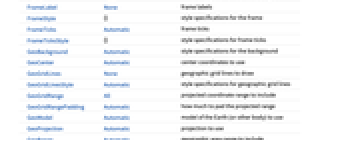
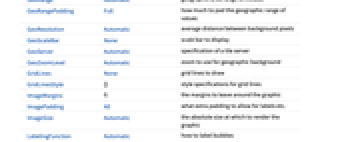
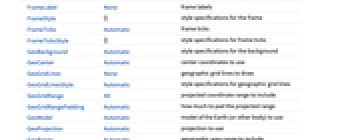
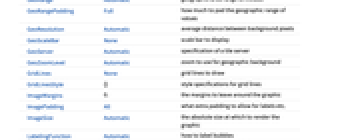
Examples
open all close allBasic Examples (2)
Scope (24)
Data and Wrappers (10)
Specify entities and values as separate lists:
Use QuantityArray for the values:
Use an entity property directly with entities:
Specify entities and values together:
Items in each set of data are colored the same:
Nonpositive data is taken to be missing:
Use wrappers at any level in the data:
Styling and Appearance (7)
Use an explicit list of styles for the groups of bubbles:
Use any gradient or indexed color schemes from ColorData:
ChartBaseStyle can be used to set an initial style for all chart elements:
Style can be used to override styles:
Use any graphic for pictorial bubbles:
Use built-in programmatically generated bubbles:
Use a theme with a simple background map:
Use a theme with a high contrast color scheme and bright bubbles:
Labeling and Legending (7)
Options (33)
AspectRatio (1)
By default, the ratio of the height to width for the plot is determined automatically:
Make the height the same as the width with AspectRatio1:
Use a numerical value to specify the height-to-width ratio:
AspectRatioFull adjusts the height and width to tightly fit inside other constructs:
Axes (1)
By default, Axes are not drawn for GeoBubbleChart:
Use AxesTrue to turn on axes:
Use AxesOrigin to specify where the axes intersect:
AxesOrigin (2)
AxesStyle (1)
BubbleScale (2)
ChartBaseStyle (1)
Use ChartBaseStyle to style all bubbles:
ChartBaseStyle combines with ChartStyle:
ChartElementFunction (2)
Get a list of built-in settings for ChartElementFunction:
ChartElements (1)
ChartStyle (3)
Use ChartStyle to set the style:
Use gradient colors from ColorData:
Use indexed colors from ColorData:
ColorFunction (2)
Color by longitude coordinate value:
Use ColorFunctionScaling->False to get unscaled height values:
ColorFunction overrides styles in ChartStyle:
Use ColorFunction to combine different style effects:
Frame (4)
GeoBubbleChart does not use a frame by default:
Use FrameTrue to draw a frame around the plot:
FrameLabel (4)
GeoBackground (1)
GeoProjection (1)
Applications (2)
Properties & Relations (9)
Use BubbleChart to show bubbles for general data:
Use GeoRegionValuePlot to show values with colored regions:
Use GeoGraphValuePlot to show the values on geographic networks:
Use GeoHistogram to aggregate locations into bins:
Use GeoSmoothHistogram to generate smooth densities from locations:
Use GeoListPlot for individual locations:
Use GeoVectorPlot and GeoStreamPlot for vector fields:
Draw contours on a map with GeoContourPlot:
Smoothly shade a map using color with GeoDensityPlot:
See Also
GeoListPlot GeoSmoothHistogram GeoHistogram GeoRegionValuePlot GeoDensityPlot GeoContourPlot BubbleChart GeoGraphics GeoDisk
Function Repository: Cartogram
History
Text
Wolfram Research (2017), GeoBubbleChart, Wolfram Language function, https://reference.wolfram.com/language/ref/GeoBubbleChart.html.
CMS
Wolfram Language. 2017. "GeoBubbleChart." Wolfram Language & System Documentation Center. Wolfram Research. https://reference.wolfram.com/language/ref/GeoBubbleChart.html.
APA
Wolfram Language. (2017). GeoBubbleChart. Wolfram Language & System Documentation Center. Retrieved from https://reference.wolfram.com/language/ref/GeoBubbleChart.html
BibTeX
@misc{reference.wolfram_2025_geobubblechart, author="Wolfram Research", title="{GeoBubbleChart}", year="2017", howpublished="\url{https://reference.wolfram.com/language/ref/GeoBubbleChart.html}", note=[Accessed: 11-December-2025]}
BibLaTeX
@online{reference.wolfram_2025_geobubblechart, organization={Wolfram Research}, title={GeoBubbleChart}, year={2017}, url={https://reference.wolfram.com/language/ref/GeoBubbleChart.html}, note=[Accessed: 11-December-2025]}